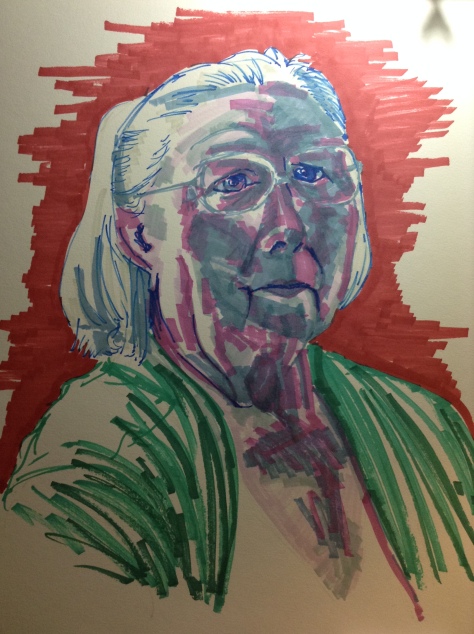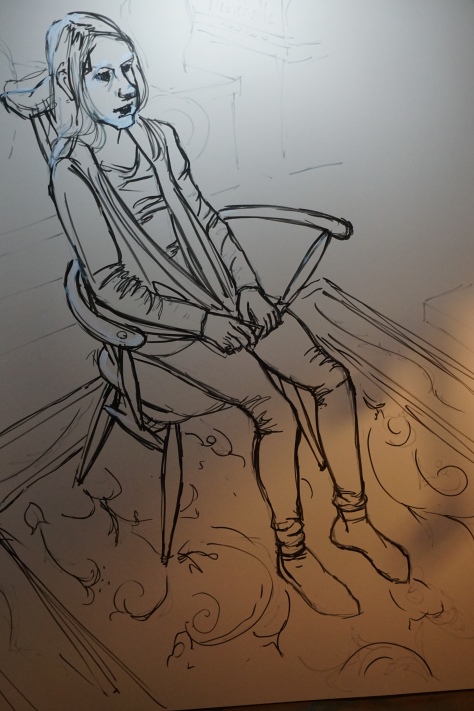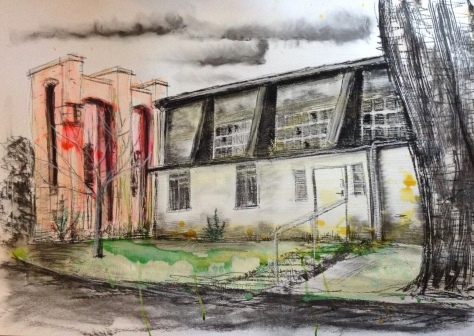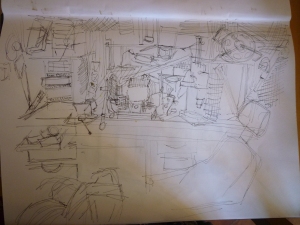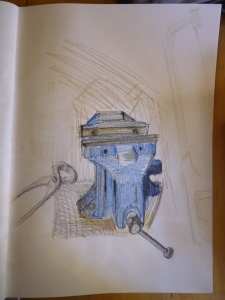My progression throughout this course has been one of deconstruction. My representational drawing skills were already well informed before I started the course, my ability to interpret this information into a more expressive piece was lacking.
My major concern, was the ability to create a sketchbook of work to put into a final picture, I felt this was my weakest area, it is still something I need to work on. I am still coming up with ideas and experimentation on the final picture, but it would not be as layered a response if I had not done a tight sketch that showed me what the major lines of an image interested me enough to do the picture in the first place.
I have come to accept my mistakes as potentially happy occurrences rather than the ending of a picture and by mixing up the mediums I’ve used to create with I have played with a colourful mess which has really ruined the lounge rug. But I hope long term will look good on the walls of friends and families who have followed my progress in the last year on my Facebook timeline.
My use of language to describe what I am attempting to convey has progressed well, an understanding of the major art movements was never going to be instantly learnt but every artist that I’ve looked at and and read about in this last year has fascinated me and taught me more. having moved out the bedside table before Christmas to fit in a bookcase, I find I am yet again in need of another to clear the floors of 2 rooms.
I haven’t seen as many exhibitions as I would have liked, as much as my children don’t have a particularly low boredom threshold, my purse isn’t bottomless, I have to be able to bribe them with a trip to the attached shop every time and London is an expense too far,. However I have discovered some well curated sites at an acceptable drives distance that have afforded me a chance to look at work close-up so I can assess techniques and steal like an artist (not a long book, but it whiled away some time and a glass of wine at Waterloo, waiting at my one and only train trip to London on an OCA drawing trip)
The ability to immediately look up an artists back catalogue online the moment I’ve finished in a gallery has helped me further, good quality photos exist and contemporary artists who list their work online have this handy how it looks in a room feature attached so you can judge the effect of a piece, even if you aren’t able to be in front of it.
Which finally leads us on to Assignment 5. I don’t have a final picture that sums up the whole of my efforts. I could quite happily keep on producing pictures of the cathedral ad-infinitum. I originally planned to work around the outside, but this is England and it gets a bit soggy so sometimes when I got to draw there, I headed inside, then I worked out I was kind of spiralling in from a distance anyway, the view from the A36 with the road signs is probably as close to a Dennis hopper as I can say I got, the view from Culver street car park places it in its surroundings well, but I sparkled it up so much I think it lost the simplicity of Hoppers work.
The closer views inside the close are more reminiscent of Monet, the views I picked, the pastel version being the best, without going for a lot of repeats in different lighting situations.
I think I succeeded in my initial desire to achieve pictures of the cathedral that are a step removed from a (to me) tired sketch back along the old town path where the cathedral rises from the water meadow. I think I have given my pictures energy, the side door up to the roof being a major favourite of mine, as are the gate to the close and the altar pictures. My exposure to a near constant stream of John Piper pictures at various venues has kept me on task to look at my use of line and shade to add a sense of depth. This I feel is most apparent in the long view of the altar in blues and greens, the arches repeat themselves over and over.
The chapter house has been a joy to work from, the light inside and out through the glass creates merry hell on the contours of the building and roof which I have enjoyed.
Which brings us on to scale. I realise my work has gotten a bit big with this assignment, the building is itself not small and producing something that gives a sense of sheer size and weight to the stone meant going large. the final picture as delicate lead-work just did not need to be bigger than A2, so it isn’t.
The work in part 5 certainly would not exist without parts 1-4 being before it and only picking up to 15 pictures to represent my growth throughout the year is going to be hell.


